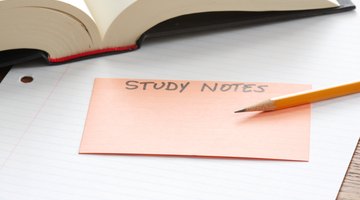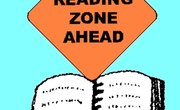Cue cards or flashcards are a memory device used in test preparation, acting auditions and oral presentations. They can be a speaker's best friend, but they must be used properly to be effective. Simple techniques are used so information on the cards can catch the speaker's eye at just the right moment to cue memory. Once the cards are created, the speaker should use them to rehearse and revise and edit the cards as needed.
Use Short Bullets
Create cue cards to be short bullets of information. Each card should contain one main idea and keywords as a guide for that specific section of the speech. Avoid writing full sentences, because these are difficult to read while presenting and may cause more confusion when a speaker is nervous. Susan Dugdale, a veteran speaker and speechwriter, explains that a clear presentation also requires eye contact with the audience for a smooth delivery. Writing cure cards with bullets will keep the orator from reading his entire speech.
Color Code Topics
Categorize the cue cards and their information by using particular colors for each topic. Highlight each section of the speech in one color. This will help the speaker's eyes note transitions, and when cues cards are used during rehearsals, the colors become additional memory prompts. Use a bright color to highlight key points and facts that are difficult to remember. This ensures the speaker won't skip them if she feels nervous or rushed.
Include Cues to Guide the Speech
Add cues to the cards that will not be spoken but will assist with the overall presentation. For example, placing a card number in the same location on every card can help a speaker maintain a pace during the speech and will keep the speech note cards organized. Other cues such as "eye contact" and "breathe" return the speaker's attention to the audience when he might be tempted to speed up and just read from the cards. If the presentation has a time limit, it can help to include time estimates on two or three cue cards throughout the set. This keeps a speaker on pace to finish in the allotted time.
Aim for Clarity and Readability
Design and write cards to be easily read at a glance. This is done with neat handwriting in a font size that is larger than normal. Use the white space of a card to guide the eyes to the most important information. Use a “less is more” approach. A card that is cluttered or difficult to read will not be effective and may increase the speaker's anxiety if the facts are hard to find. If the presentation requires the use of visual aids, include prompts on the cards to cue when to display them or draw the audience's attention to them. While it might be tempting to type the cue cards in order to enhance legibility, writing the cards neatly by hand provide the added benefit of improving memory.
Use Transitions to Anticipate Upcoming Information
Place transitional statements at the bottom of the card that foreshadow the information to come. On the last card for each topic, for example, write a brief transitional statement at the bottom that previews what the next topic will be. Motivational speaker Nick Skellon uses this simple tactic to make his speech delivery smoother. By giving himself a hint about the information on the next card, he can start speaking, while making eye contact, as he flips his cards. He suggests using only one side of each cue card.
Practice with Cue Cards
Whether preparing for a test, an audition or an oral presentation, using the cue cards to practice the material is beneficial because it can help identify areas that need improvement. Rehearsing the information with cue cards also helps identify the right pace to strive for and can further aid memorization of the material.
Related Articles
References
Writer Bio
Michael Green graduated from one of the top journalism schools in the country, the University of Missouri, where he also received his master's degree in education. Green has taught creative writing, journalism and health and has been published in "Body Balance," "Alive" and "PUSH Monthly."











